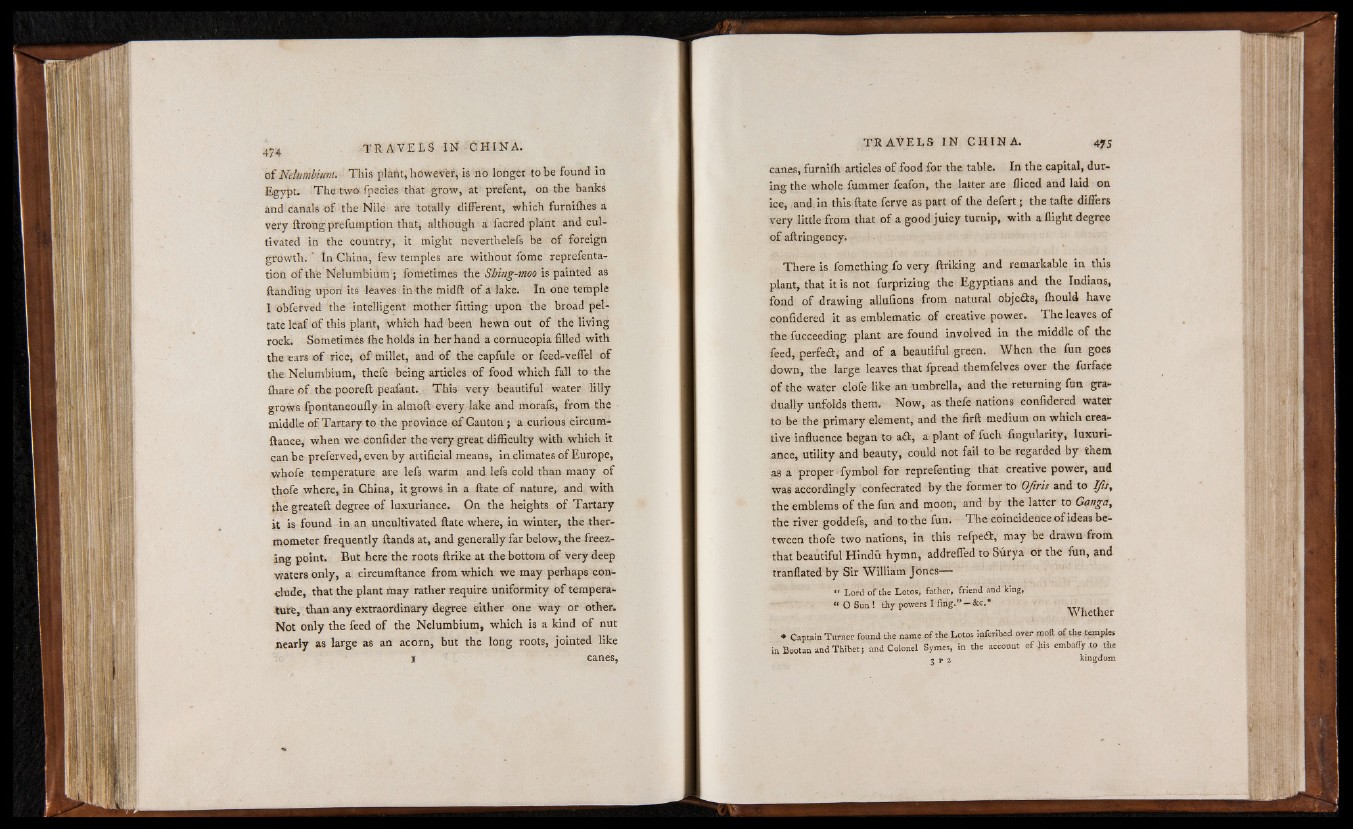
o f Nelumbium. This plant, however, is no longer to be found in
Egypt. The two fpecies that grow, at prefent, on the banks
and canals o f the Nile are totally different, which furnifhes a
very ftrongprefumption that, although a facred plant and cultivated
in the country, it might neverthelefs be o f foreign
growth. ’ In China, few temples are without fome reprefenta-
tion o f the Nelumbium ; fometimes the Sbing-moo is painted as
ilanding upon its leaves in the midft o f a lake. In one temple
1 obferved the intelligent mother fitting upon the broad peltate
leaf o f this plant, which had been hewn out o f the living
rock. Sometimes ihe holds in her hand a cornucopia filled with
the ears o f rice, o f millet, and o f the capfule or feed-veffel o f
the Nelumbium, thefe being articles o f food which fall to the
ihare o f the pooreft peafant. This very beautiful water lilly
grows fpontaneoufly in almoft every lake and morafs, from the
middle o f Tartary to the province o f Canton ; a curious circum-
ftance, when we confider the very great difficulty with which it
can be preferved, even b y artificial means, in climates o f Europe,
whofe temperature are lefs warm and lefs cold than many o f
thofe where, in China, it grows in a ftate o f nature, and with
the greateft degree o f luxuriance. On the heights o f Tartary
it is found in an uncultivated ftate where, in winter, the thermometer
frequently ftands at, and generally far below, the freezing
point. But here the roots ftrike at the bottom o f very deep
waters only, a circumftance from which we may perhaps conclude,
that the plant may rather require uniformity o f temperature,
than any extraordinary degree either one way or other.
Not only the feed o f the Nelumbium, which is a kind o f nut
nearly as large as an acorn, but the long roots, jointed like
I canes,
canes, furnifh articles o f food for the table. In the capital, during
the whole fummer feafon, the latter are fliced and laid on
ice, and. in this ftate ferve as part o f the defert; the tafte differs
very little from that o f a good ju icy turnip, with a flight degree
o f aftringency.
There is fomething fo very ftriking and remarkable in this
plant, that it is not furprizing the Egyptians and the Indians,
fond o f drawing allufions from natural objecls, fhould have
confidered it as emblematic o f creative power. The leaves o f
the fucceeding plant are found involved in the middle o f the
feed, perfect, and o f a beautiful green. When the fun goes
down, the large leaves that fpread themfelves over the furface
o f the water clofe like an umbrella, and the returning fun gradually
unfolds them. Now, as thefe nations confidered water
to be the primary element, and the firft medium on which creative
influence began to a£t, a plant o f fuch fingularity, luxuriance,
utility and beauty, could not fail to be regarded by them
as a proper fymbol for reprefenting that creative power, and
was accordingly confecrated by the former to Oßris and to Ijis,
the emblems o f the fun and moon, and by the latter to Ganga,
the river goddefs, and to the fun. The coincidence o f ideas between
thofe two nations, in this refpecl, may be drawn from
that beautiful Hindü hymn, addrefled to Surya or the fun, and
tranflated by Sir William Jbnes—
“ Lord o f the Lotos, father, friend and king,
“ O Sun ! thy powers I fing.” — &c.*
Whether
* Captain Turner found the name of the Lotos infcribed over moil of the temples
in Bootan and Thibet; and Colonel Symes, in the account of-Jus embafly.to the
9 p 2 kingdom